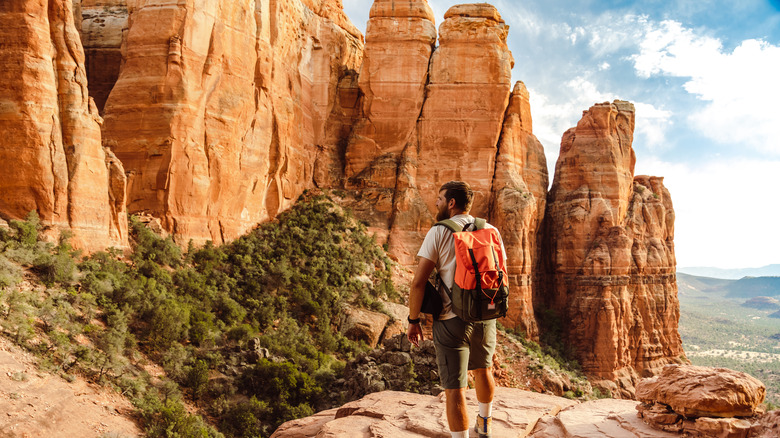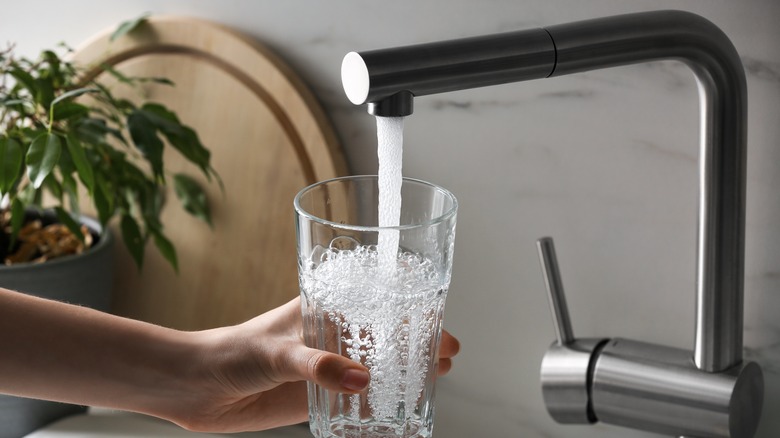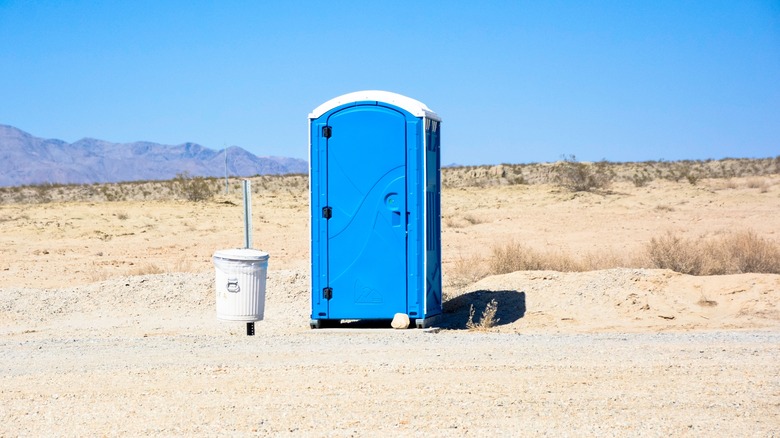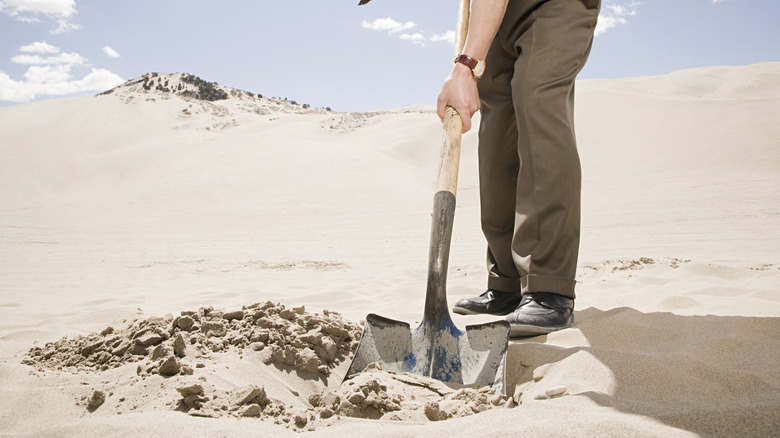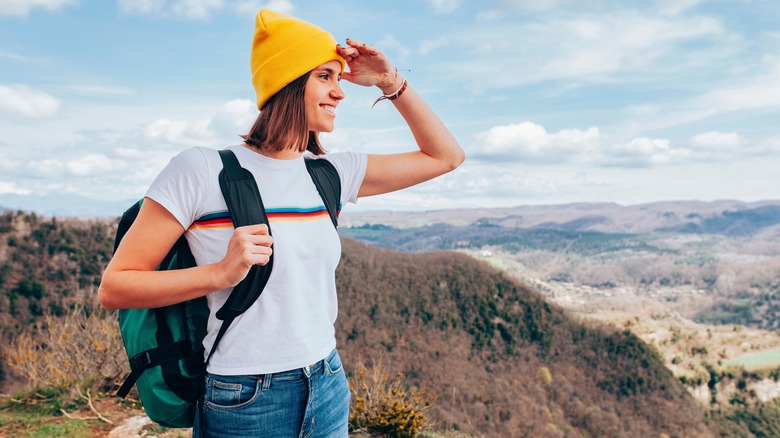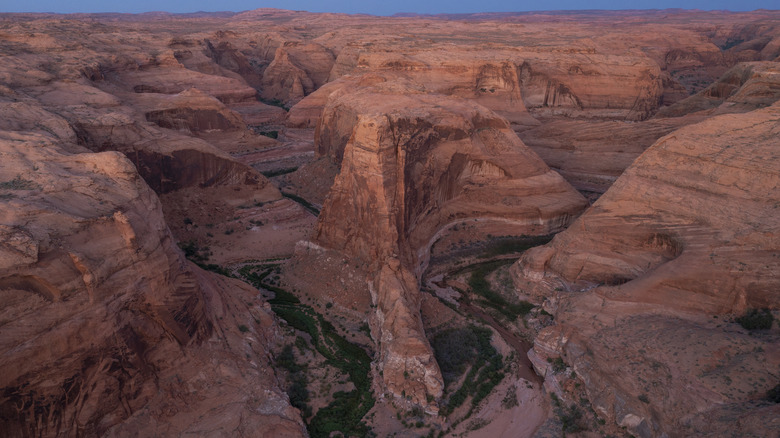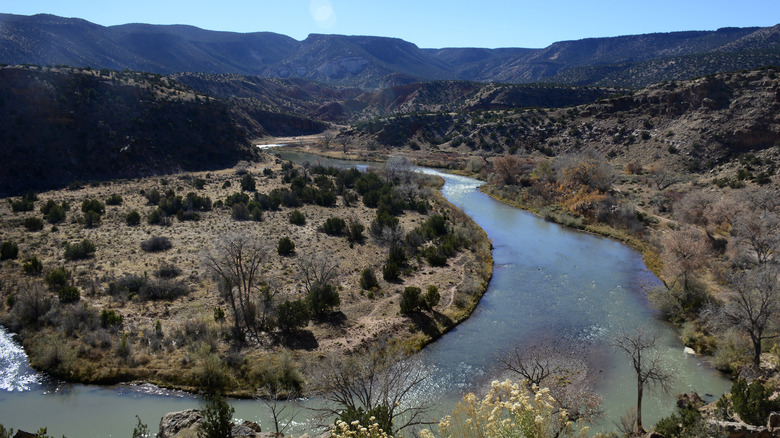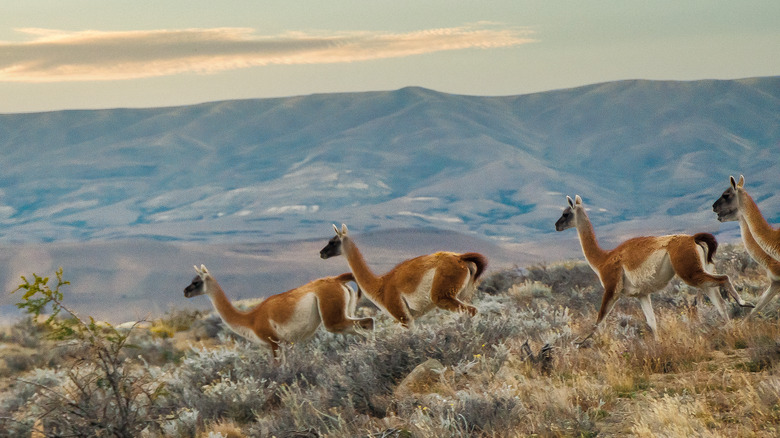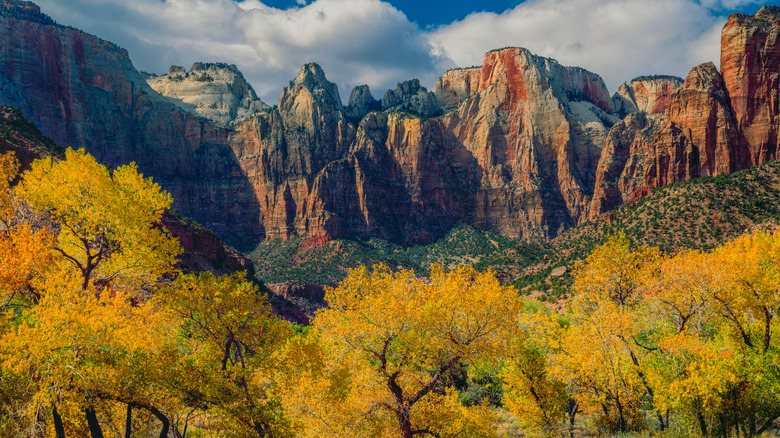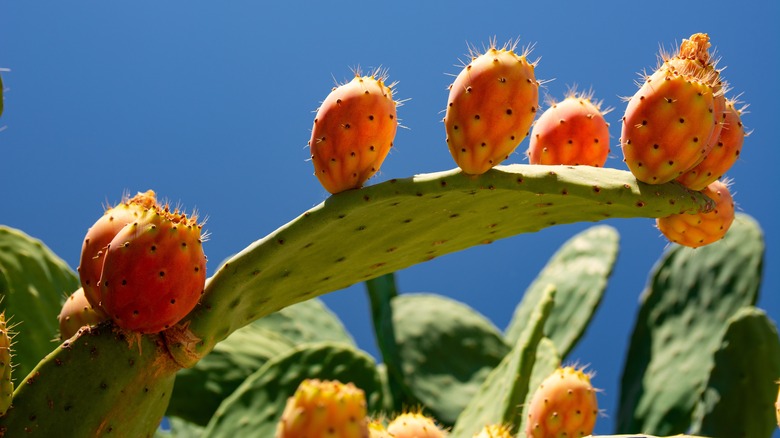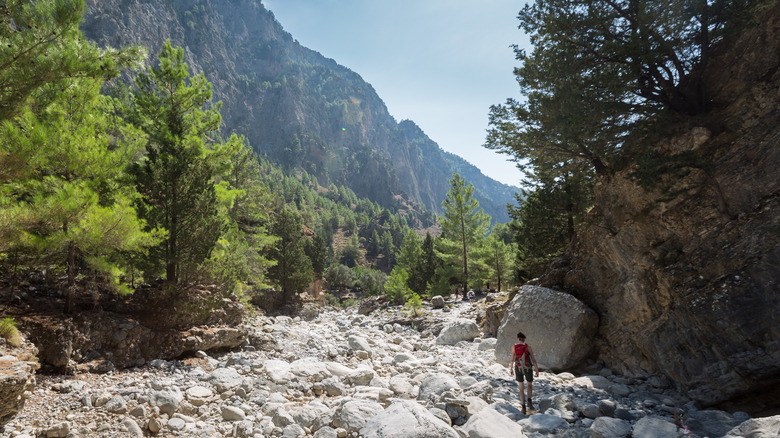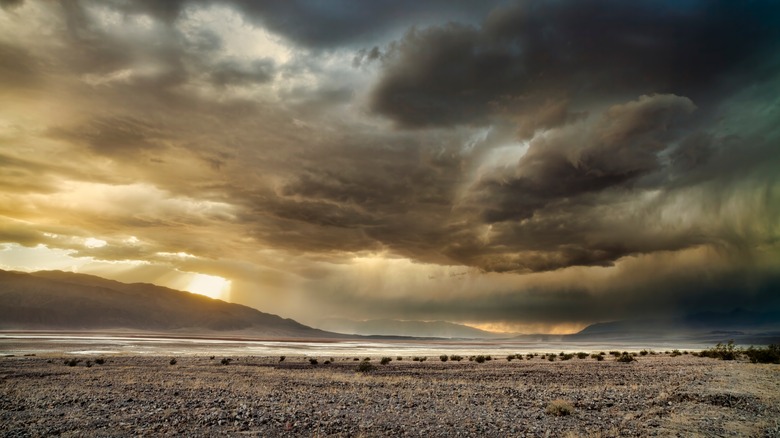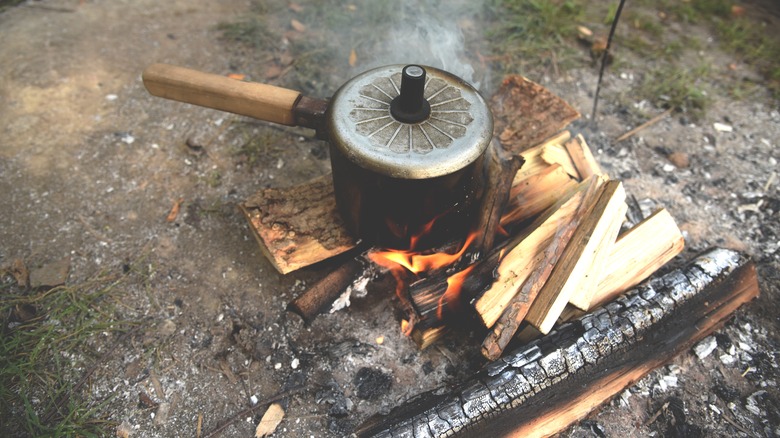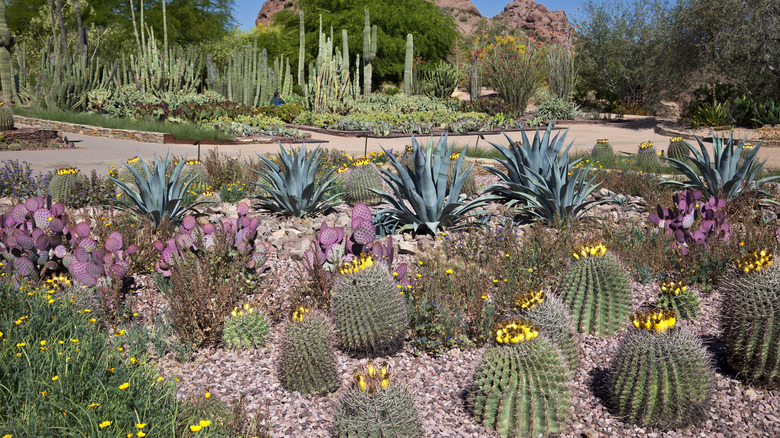How To Find Water In The Desert
A swollen sun beats down on your head. Dirt and sand stretch into the distance for miles all around — there are no roads, no people. Your papery tongue runs over the parched roof of your mouth for moisture and comes away dry. Heat waves ripple in the air, creating a mirage of water in the distance, but the longer you chase after it, the further away that joyous liquid seems to get. You're lost in the desert and in desperate need of a drink. Where do you find one?
Traveling through the deserts can be a beautiful experience, such as riding a camel in the Gobi Desert. But they can also be some of Earth's most unforgiving biomes, filled with prickly plants, lethal animals, and temperatures hot enough to cook an egg. Movies do them justice by depicting the dehydrated main character hallucinating as they wander aimlessly for water. That said, there is water there if you know where to look.
Come prepared
We'll assume you're not currently lost in the desert looking for water. If you are, good luck, and skip to the next section. Before you get out to the desert — even if you're just passing through — prepare in advance. The American Hiking Society suggests drinking at least a cup or two of water before you head out. Hydrate as much as you can while you have a limitless tap. Waiting until you're thirsty is effectively waiting until you're already dehydrated (via Baylor College of Medicine). Drink even if you don't feel like it. Avoid alcohol and soft drinks, as these tend to worsen your dehydration.
Bring lots of water, more than you think you'll need. "It is recommended to drink around eight glasses of water per day which equals around 1.5-2 litres per day," GP Dr. Angela Rai told The Independent. "However, in hot weather and especially if we are exercising, our water requirements will go up. We need to drink up to around three litres a day on a hot day." Remember, you're losing a lot more water than usual to perspiration. Take a cue from desert explorers who have done this before. Régis Belleville reportedly consumed 4 liters a day while crossing the Sahara on a camel, and so did Louis-Philippe Loncke in Australia's Simpson Desert.
Reduce exertion as much as possible
Sweat is a lot more complex than it may seem. Some people assume we produce it because water is cold, so moisture on your skin should help drop your temperature. In reality, the sweat we secrete draws away the body's heat and evaporates, creating a cooling effect via heat vaporization. The problem is that all that sweat is water leaving your body's reserves when you need it most.
Exerting yourself too much heats up your body, pushing you closer to the brink of heat illness – which could kill you (via Cleveland Clinic). To compensate, your body sweats more to drop your temperature, further depleting your limited water stores. So, the first tip is to slow down a bit. Rushing about in panic for water will only worsen your situation.
Second, don't search during the hottest part of the day. In Arizona's Sonoran Desert, that would be between 2 p.m. and 5 p.m., according to AZ Central. However, the window will differ depending on your location and shifting environmental factors. Hiking guides often recommend not hiking at all during this time. On average, people can survive for three days without water (via Medical News Today), so your situation may not be as dire as you think. Take to the shade and rest, waiting for cooler temperatures in the late afternoon to resume your search.
Don't drink urine or sweat
At this point, we wager everyone has seen Bear Grylls, former host of "Man vs. Wild," drinking his urine to survive in the desert. Funny memes aside, it's misled people into believing they can recycle their pee. You see, your body is a highly efficient machine that only disposes of things it doesn't need. It uses urine as a "trash chute" to get rid of excess salts and chemicals, particularly sodium. Ingesting urine can bring your sodium levels back up, thus making you more thirsty and dehydrated. It throws off your body's electrolyte balance and reintroduces toxins your body has disposed of, causing your kidneys to work harder and making survival even more difficult. Don't drink your pee, folks.
"But what about sweat?" you say. Urine's a big no-no, but surely sweat is safe. According to registered nurse Angela Ballard (via Mel Magazine), "[Sweat] should be okay to drink in small quantities." Not so fast, though. There's a big asterisk there. Ballard explained that drinking sweat does more harm than good when you're dying of dehydration. Sweat contains whatever bacteria is on your skin, plus the salts your body was trying to get rid of, which is stuff your body has to process out, too. It takes a lot of effort to collect sweat with fabric and squeeze it into your mouth, making for an ineffective — and disgusting — way to hydrate. Thankfully, there are other methods you can try.
Don't build a solar still
Before we get to ways to find water, we have one final anti-recommendation: don't build a solar still. For the uninitiated, this is a DIY contraption that can purify unsafe water using distillation. In layperson's terms, you're using the sun's heat to condense and purify a water source so it's safe to drink. It works, and in a desert environment, it can pull moisture from the soil or vegetation even if you don't have liquid water to purify. Despite being a means to procure water, we recommend against building one if you're in a desperate survival situation.
In "Understanding Solar Stills," on page three, authors Joel Gordes and Horace McCracken say, "The energy from the sun used to distill water is free. But the cost of building a still makes the cost of the distilled water rather high." In other words, it will take a lot of backbreaking effort to construct a solar still when the last thing you want is to overexert yourself. It requires materials you may not have, such as a digging tool and fabric, which may force you to use clothing you should be using to cover up. Solar stills are great if you live in the desert and have spare supplies. They're not great when you're stranded and desperate for water.
Use altitude to your advantage
Chances are, you're out in the desert in the first place for outdoor fun, such as the Siphon Draw Trail near Phoenix. Many desert hikes take you up rocky mountains overlooking flat planes. If it's at these altitudes that you realize that you're in desperate need of agua, don't immediately rush down to the base. Use your vantage point to spot potential sources of water.
Check for glimmering sun reflections that distant water sources make—though do be wary that heat waves can create the illusion of non-existent water sources, especially on roads. Check for places where rainwater may have collected and areas of lower elevation where water would naturally flow to. Put your physics hat on; imagine where gravity would take water if there was a sudden rainstorm, and mentally mark out those places.
Barring that, note topographical features resulting from water erosion–canyons, ravines, gullies, rills, dry creekbeds, and so on. These are the next most likely places to contain water, even if they appear dry. Another tell is desert plants, which naturally space themselves out to get as much water as possible; thicker, denser vegetation could indicate a nearby water source. Also, look for increased wildlife activity, as this could mean there's a watering spot that they're flocking to. Hopefully, you have a pair of binoculars, as this will make sighting water sources much easier.
Check for north-facing canyons
Were you taking a scenic road trip to the Grand Canyon when you got lost, leaving you struggling to find a water source? Canyons are a great place to start. After all, most canyons form when rivers carve down through the earth. The river that eroded it is usually still there. Some may be dry, but don't give up hope just yet. Like other low-elevation and water-eroded topographical features, canyon bottoms make perfect water-gathering repositories. Survival instructor Tony Nester said on Outside, "North-facing canyons can often hold large pools of water in the sandstone or basalt basins." This is because these areas get plenty of shade in the late afternoon, preventing any water that may be there from evaporating.
If you're in the Southern Hemisphere, though, it's the reverse. Water is likely to appear in south-facing canyons. Nester stated the best technique for locating a north/south-facing canyon is to use a topographical map. Otherwise, use your vantage point from earlier to spot them. Use the sun if you don't have a compass to tell which direction is north or south. Even if you find no water, canyons offer shade while you wait out the hottest parts of the day.
Listen for running water
As you descend from a higher elevation, you will likely be on the hunt for the evidence of water you saw on high. Let your senses guide you before you wander too far in a promising direction. Anyone who's been to a desert knows the biome is naturally very quiet, likely owing to scant life, limited biodiversity, flat topography, and high atmospheric attenuation. Sound seems to carry further since there's less in the way to obstruct it or muddle it. Use this peace and quiet to your advantage and listen for water sources.
Come to a complete stop for a good read; rustling clothing, footsteps, and heavy breathing could easily cover up the noise. Identify that telltale gurgling of running water or the sounds of waves lapping up on a pond or lakeside. Granted, the sound will be very faint, but you'll know you're close if you hear it. As you go about looking for water, stop and listen periodically. Otherwise, you might walk right past a place to drink and never know it.
Follow the wildlife
You're not the only one dying of thirst out there. Animal life adapted to this cruel environment may be able to survive longer than you can, but water is still the quite literal difference between life and death in the desert. Species of all kinds, desert or not, naturally gravitate towards water sources. When in Rome (or in this case, the desert), do as the Romans (or in this case, the animals) do. They could potentially lead you to salvation.
Take note of swarms of insects, for example, or passing birds. They congregate around or stay in the general vicinity of water sources. If you don't see anything, check the ground for fresh animal tracks that seem to go in a single direction. Keep what we discussed about topographical signs of water in the back of your mind. For example, animal tracks leading toward a ravine could be a very good indicator.
Not all animals necessarily hang around water sources, though. Take the thorny devil of the Australian bush as one example. It can quite literally suck water out of the earth with its specialized skin, so be wary of which wildlife you rely on.
Identify water-guzzling plants
We mentioned using plants as a way to identify a nearby water source. However, desert plants, on the whole, tend to require very little to survive. They have developed highly efficient water retention systems and defenses against water-stealing predators, such as a mesquite tree's sharp thorns.
A glance at desert plants may give the impression that they look dry and nearly dead, and there may not be many heavy clusters. That said, some are more gluttonous than their peers. They consume a lot of water and, therefore, are likely near a good source of it, or their root systems are ideal for digging a seep — something we'll discuss later.
Tony Nester of Outside advised, "Look for cottonwoods, willows, and sycamores." These are most common in canyons. Copses of them could indicate a spring, and some — the cottonwood being a good example — are easy to spot thanks to bright green leaves. Nester also says aspens and palms are good choices, the latter of which could point to a life-saving oasis in certain deserts.
Eat some cactus fruit
As you continue your search for water, there may be a ready way to get some hydration from the plants you're passing by. Cactus fruit is a worthwhile start. You can find prickly pear across the Western Hemisphere, such as Arizona and Mexico. Locals eat them, and they have a lot of water content despite being a desert fruit. Plus, they're a "superfood" chockful of nutrients such as vitamin C and antioxidants. Before you dig in, know they've got a mean covering of tiny hair-like spines that will stick to your tongue and linger there, painfully, until you find a way to get them out. Based on personal experience, this ordeal can continue all day long.
You need gloves to prepare prickly pear unless you're okay with picking those tiny spines out of your hands, too. The easiest way to prepare them is to cut each fruit in half and scoop out the insides. Otherwise, you'd need to painstakingly peel the skin, which risks spines entering the flesh. The red juice will make this a messy affair, but it will likely be worth it for the hydration. Remember, this is a stopgap; juicy foods replenish some water, but plain water is the ideal way to quench your thirst.
Dig a seep for water
Perhaps you've been unsuccessful in finding water, and you're starting to lose hope. Fear not. Even without obvious sources, it might be beneath your feet. Have you ever seen a movie where someone digs a hole in the ground, and it fills with water? That's known as a seep and is an actual survival technique. Water gathers in the soil deep in the earth, even if there's less in desert areas. The key is to look for ground where you're most likely to find water, such as a dry creek bed lined with plants. Any place that had water at some point — and features a denser concentration of plant life — is a good place to start.
Pay attention to signs of moisture, such as damp sand, and dig down to it in the evening when it's cool. Remember those water-loving plants we mentioned? Dig into their root systems if you can. That's where they gather their water, so a seep will likely have more success there.
Collect rainwater
Let's not beat around the bush: deserts don't have a lot of rain. That's part of the reason they're classified as deserts. It's doubtful that you'll be out in one when rain hits. Still, this survival tip is a must-have if you get lucky with a sudden downpour. Nimbus or nimbostratus clouds are a good bet that the heavens are about to upend themselves, so if you see any, get to work on a means of collecting rainwater.
Set out any jugs, pots, or water bottles and let them catch rainwater. If you have a piece of fabric — particularly a waterproof one, like a tarp or poncho — and some rope, then you can build a funnel. The Art of Manliness recommends tying the fabric's four corners to some surrounding trees or sturdy bushes and weighing it down at one edge with a rock. Place your water collection receptacle beneath.
When that is done, get to shelter and let gravity do the work. Just be aware that you can't drink the rainwater as is. The CDC warns that rainwater can carry contamination with it from the air and any surface it touches. Make sure to always treat rainwater before drinking it.
Treat any water you find
So, you've acquired some water from a stagnant pool, a pond or lake, a running source like a creek, a seep, or rainwater. Don't be so quick to gulp it down. Living in a civilization where drinking water comes straight out of the tap, we often forget that the stuff in nature is usually not safe to consume fresh. Doing so, according to the CDC, can lead to diarrhea and vomiting — two things that are going to dehydrate you even faster. "There are two means of treating water for drinking purposes: filter it, then purify it. Period," advised Jeff Weinstein, Medical Operations Supervisor at Global Rescue. Filtering takes care of protozoan cysts, bacteria, and sediments while purifying catches smaller threats like viruses.
Use a water filter. Pre-filter with some fabric or a coffee filter to remove larger particles. Ideally, come prepared with a certified water filtration device before going out. There are water bottles that do this either with a conventional filter or a purifying UV light (or, ideally, both). If that's impossible, the CDC suggests bringing your untreated water to a rolling boil for at least one minute to kill bacteria, pathogens, and parasites. You can also use disinfectants like household chlorine bleach and purifying tablets, but be sure to get the doses right. It's a lot of extra work, but you'll be glad you took the time after you don't get sick.
Can you get water from a cactus?
When people think of drinking cactus water, they might imagine that scene from "Avatar: The Last Airbender" where Sokka lops the top of a cactus off and drinks the liquid inside and experiences wild hallucinations as a result. This would be preferable, were it the case, since the reality is much less humorous. Cactuses don't usually contain drinkable liquid; instead, you get an acrid, chemical-laden, spongey flesh filled with alkaloids. Translation: you won't be tripping; your kidneys will be working overtime to process toxins. That's not even the worst thing that could happen. Some cactus flesh will make you vomit, induce diarrhea, lead to temporary paralysis, burn your skin, or, if it gets in your eyes, cause permanent blindness.
If you think about it, it makes sense. Cactuses would not last long if anyone could crack them open and take a drink, especially in a place where water is a precious resource. That said, there is at least one known species whose contents are safe to ingest: the fishhook barrel cactus. You could get a bit of hydration from it, but be aware that eating it raw won't be enjoyable.
